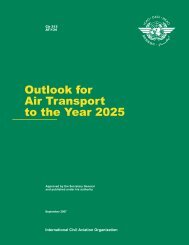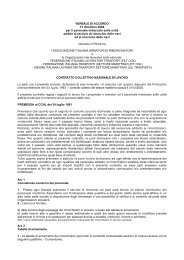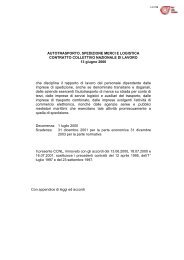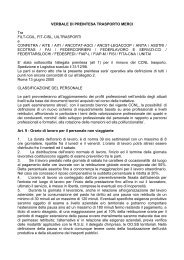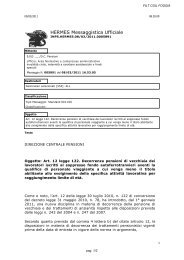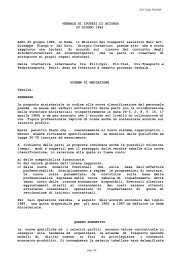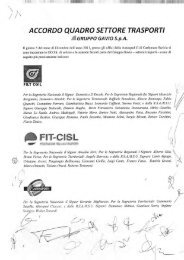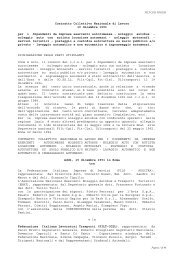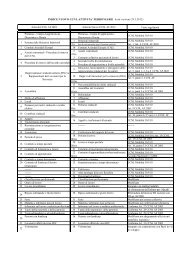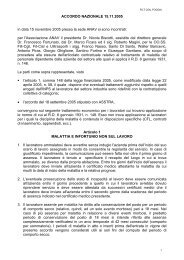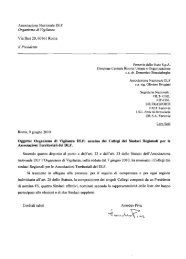Outlook for Air Transport to the Year 2015 - FILT CGIL Foggia
Outlook for Air Transport to the Year 2015 - FILT CGIL Foggia
Outlook for Air Transport to the Year 2015 - FILT CGIL Foggia
Create successful ePaper yourself
Turn your PDF publications into a flip-book with our unique Google optimized e-Paper software.
Chapter 2. <strong>Air</strong> <strong>Transport</strong> Trends and Challenges 2156. In <strong>the</strong> area of air cargo, <strong>the</strong> highly sophisticated airline/parcel express delivery companies, which grewsubstantially in <strong>the</strong> past decade, continue <strong>to</strong> expand this specialized service. These companies operate large jetcargo fleets combined with surface delivery systems <strong>to</strong> provide continental overnight deliveries and second dayintercontinental services via strategically placed sorting hubs. This concept has also been adopted by a number ofpostal administrations.Privatization, national consolidation and transnational ownership57. Privatization of State-owned airlines has been one of <strong>the</strong> preeminent trans<strong>for</strong>mations in international airtransport, where airlines in all but a handful of States had been State-owned until recent times. It is a process ofdivestment, by various methods, of State-owned or -controlled equity and may be carried out in a phased mannerover time. Some States may consider a minor sale of shares as privatization. The motives <strong>for</strong> privatization havebeen highly diverse, ranging from purely economic considerations or improving operating efficiency andcompetitiveness <strong>to</strong> a more pragmatic desire <strong>to</strong> reduce <strong>the</strong> heavy financial burden <strong>for</strong> States <strong>for</strong> financing capitalinvestment in new equipment. Whatever <strong>the</strong> reasons, <strong>the</strong> privatization of airlines has accompanied a morecommercially-oriented outlook within an increasingly competitive environment. Since 1985, about 130 Stateshave announced privatization plans or expressed <strong>the</strong>ir intentions of privatization <strong>for</strong> approximately 190State-owned airlines. During this period, about 90 of <strong>the</strong>se targeted carriers have achieved privatization goals.58. <strong>Air</strong>lines in many parts of <strong>the</strong> world have continued <strong>the</strong> pursuit of enhanced market strength throughmergers, acquisitions or operational integration under a single holding company. The common thread of this trendis <strong>the</strong> continuing development of growth strategies designed <strong>to</strong> hold and expand existing market share, gainaccess <strong>to</strong> new markets, achieve unit cost reduction, shield <strong>the</strong>mselves against competition, and increase <strong>the</strong> scaleof operations in order <strong>to</strong> attain a critical market position. Mergers or acquisitions are easier <strong>to</strong> achieve within <strong>the</strong>same country, although some Governments have expressed concerns regarding industry consolidation and havescrutinized it.59. The opportunity <strong>for</strong> equity investment in <strong>for</strong>eign carriers has increased as many States adopted a newpolicy or amended existing rules on <strong>for</strong>eign investment or control in national airlines and relaxed air carrierownership and control conditions in air services agreements. However, most attempts <strong>to</strong> initiate transactionsinvolving a <strong>for</strong>eign majority ownership, including cross-border mergers or acquisitions, were abandoned owing <strong>to</strong>aeropolitical, economic and regula<strong>to</strong>ry complexities. Even in <strong>the</strong> implemented cases, <strong>the</strong> control and managemen<strong>to</strong>f <strong>for</strong>eign carriers was not financially risk-free. Because of <strong>the</strong>se difficulties in successful implementation, most<strong>for</strong>eign investments in <strong>the</strong> airline industry have been on a limited scale, instead of taking a majority stake orpursuing a full-scale merger, and often as part of a strategy <strong>to</strong> <strong>for</strong>ge or streng<strong>the</strong>n alliances and expand marketaccess. Never<strong>the</strong>less, <strong>for</strong>eign investments have sometimes been short-lived.___________________






